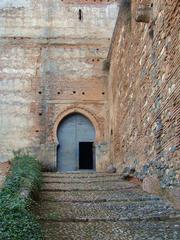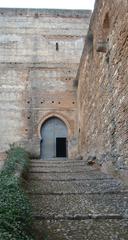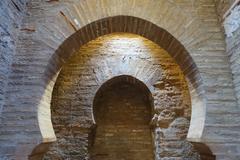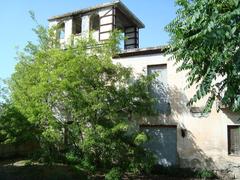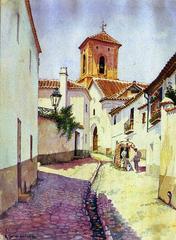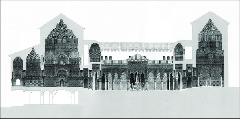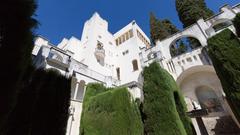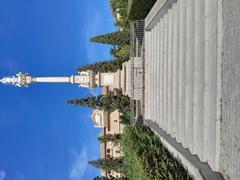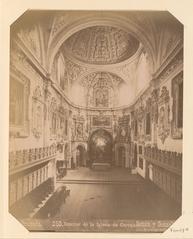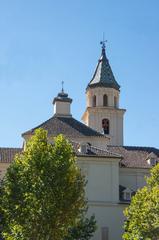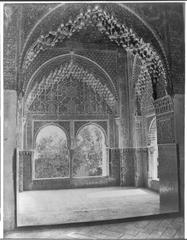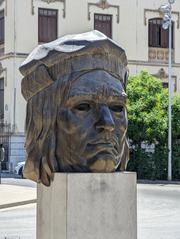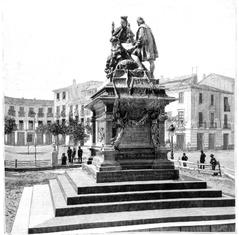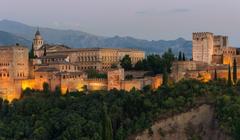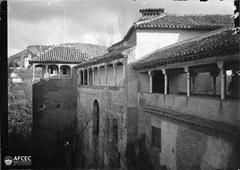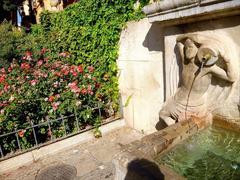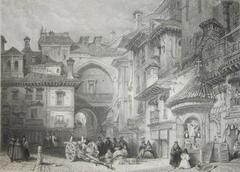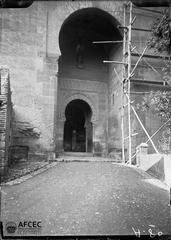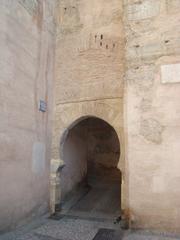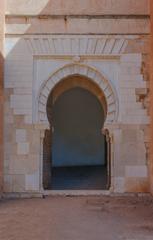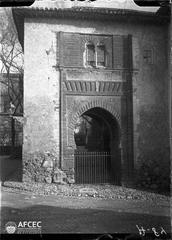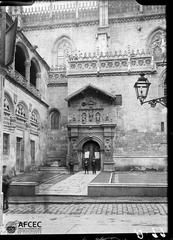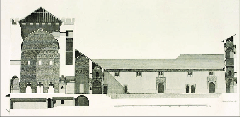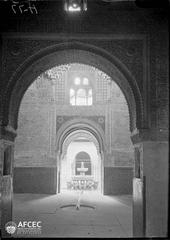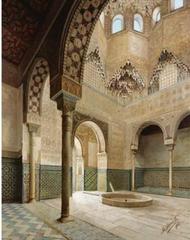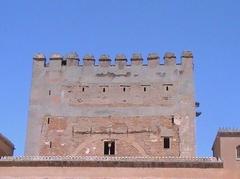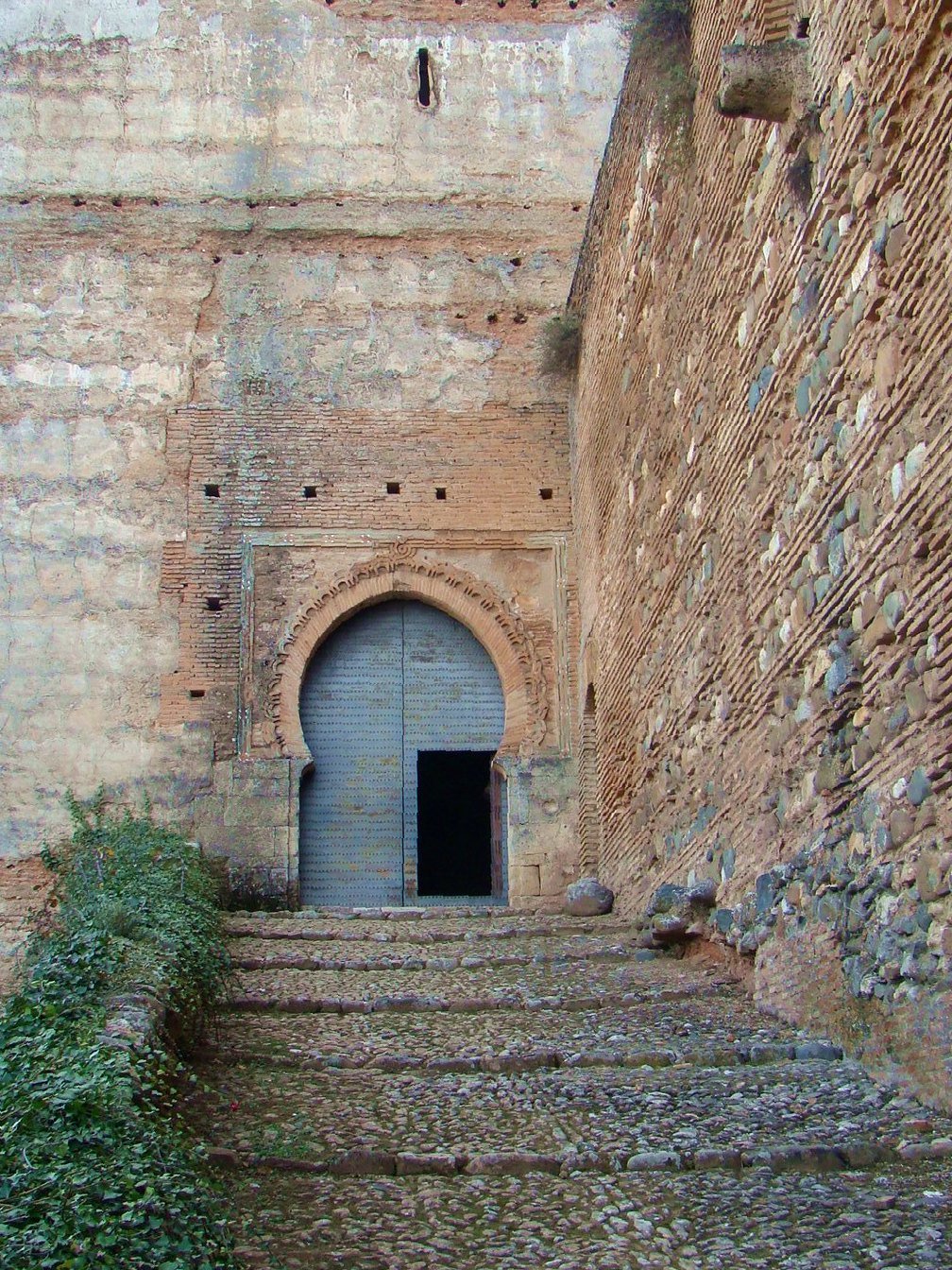
Puerta de las Armas Alhambra Granada: Visiting Hours, Tickets, and Travel Guide
Date: 14/06/2025
Introduction
The Puerta de las Armas (“Gate of Arms”) stands as one of the most historically significant gateways to the Alhambra, the renowned fortress-palace complex in Granada, Spain. Dating back to the Nasrid dynasty of the 13th century, this gate served as the principal military and ceremonial entrance to the Alcazaba—the oldest and most fortified section of the Alhambra. Built upon earlier Roman and Caliphate fortifications, the Puerta de las Armas is an architectural testament to Granada’s strategic and cultural importance throughout centuries of Islamic and Christian rule. Today, it is a compelling highlight for visitors, offering sweeping views of Granada and the Sierra Nevada, as well as insight into the city’s layered past.
This guide provides detailed information on the gate’s history, architectural features, visiting hours, ticketing, accessibility, and travel tips—ensuring a rewarding experience for every traveler. For further details, consult official resources such as the Alhambra Patronato and comprehensive travel guides (alhambra.info; Nomads Travel Guide; andalucia360travel.com).
Contents
- Historical Background
- Origins and Strategic Importance
- Nasrid Era and Architectural Highlights
- Role During the Christian Reconquest
- Cultural and Symbolic Meaning
- Location and Architectural Context
- Visitor Information
- Visiting Hours and Tickets
- Access and Accessibility
- Travel Tips
- Nearby Attractions
- Visuals and Media
- Frequently Asked Questions (FAQ)
- Conclusion
- Sources
Historical Background
Origins and Strategic Importance
The foundations of the Puerta de las Armas date back to early phases of the Alhambra’s development. Built atop Roman and later Caliphate fortifications, the gate was further fortified during the Islamic period and became the main access point between the Alcazaba and the city of Granada during the Zirid dynasty in the 11th century (alhambra.info). Its position allowed efficient control of movement and communication between the fortress and the urban center.
Nasrid Era and Architectural Highlights
The Nasrid dynasty (13th–15th centuries) marked the architectural and functional zenith of the Puerta de las Armas. Designed with a robust double-walled structure and a characteristic “bent entrance,” the gate forced attackers through a narrow, defensible passage. The pointed horseshoe arch, brickwork, and traces of colored ceramics showcase the refined military and decorative style of Nasrid Granada. The gate also connected directly to the Alcazaba’s Plaza de Armas, the military heart of the fortress (Nomads Travel Guide).
Role During the Christian Reconquest
Following the Christian conquest of Granada in 1492, the gate’s strategic importance persisted. Modifications such as the addition of the semicircular Torre del Cubo reflected evolving defensive needs, but the original Nasrid character was largely preserved (thefunplan.com). Eventually, changes in the city’s infrastructure and the collapse of the Puente del Cadí led to the gate’s closure to public use.
Cultural and Symbolic Meaning
More than a military gateway, the Puerta de las Armas symbolized the connection between Granada’s rulers and its citizens. Its name—originally Bib al-Medina (“City Gate”), later Bab al-Silah (“Gate of Arms”)—reflects its dual role as both a threshold and a place where visitors surrendered their weapons before entering the royal precinct. The gate’s presence in art, literature, and local lore further cements its cultural significance (alhambradegranada.org).
Location and Architectural Context
Positioned on the western face of the Torre de las Armas, this gate once served as the main entrance for Granada’s residents—especially before the construction of newer gates in the 14th century. Its elevated placement provided commanding views of the Darro River valley and the Albaicín neighborhood (Andaltura).
The gate is built into the lower floor of the Torre de las Armas, accessed via a ramp adjacent to the fortress walls. The recodo (bent) layout and horseshoe arch are classic defensive features of Nasrid military architecture, slowing down potential attackers and exposing them to defensive fire from above (WikiArquitectura). Decorative elements such as fragments of colored tiles and intricate plasterwork can still be seen, particularly around the arch’s frame.
A smaller postern gate, adjacent to the main entrance, provided controlled access for specific groups and enhanced security (Nomads Travel Guide).
Visitor Information
Visiting Hours and Tickets
- Opening Hours: The Alhambra complex (including the Alcazaba and Puerta de las Armas exteriors) is open daily from 8:30 AM to 8:00 PM (April–October) and until 6:00 PM (November–March). Hours may change due to maintenance or special events—always verify on the official Alhambra website.
- Tickets: Access to the Puerta de las Armas is included with standard Alhambra admission. Prices typically range from €14–€18 for adults, with reduced rates for students, EU residents aged 18–25, and free entry for children under 12 (ID required). Due to daily visitor limits, advance booking is highly recommended (alhambradegranada.org).
- Entry: The Puerta de las Armas is not a public entrance; it is experienced from within the Alcazaba area on standard visitor routes. Guided tours and audio guides are available for a deeper understanding of its history.
Access and Accessibility
- Access: The gate is reached by following signposted paths inside the Alhambra. The approach includes ramps and stairs, typical of medieval fortresses.
- Accessibility: Terrain is uneven and can be challenging for visitors with limited mobility. While there are some ramps, full wheelchair access is limited. Consult the official visitor centers for the latest accessibility support.
- Travel Tips:
- Wear comfortable shoes for uneven walks.
- Arrive early to avoid crowds.
- Bring water and sun protection, especially in summer.
- Allocate at least four hours to explore the entire Alhambra complex.
Nearby Attractions
- Alcazaba Towers: Climb the Torre de la Vela for panoramic city views.
- Nasrid Palaces: Explore the intricate palatial residences of Granada’s rulers.
- Generalife Gardens: Wander through lush Moorish gardens adjacent to the fortress.
- Albaicín Neighborhood: Discover Granada’s historic Moorish quarter, easily visible from the fortress.
- Puerta de la Justicia: Another iconic Alhambra gate, renowned for its imposing architecture.
Visuals and Media
- [Insert high-quality images of Puerta de las Armas, with alt tags such as “Puerta de las Armas entrance in the Alhambra, Granada” and “Horseshoe arch of Puerta de las Armas.“]
- Consider embedding an interactive map of the Alhambra or linking to official virtual tours for remote exploration.
Frequently Asked Questions (FAQ)
Q: Is the Puerta de las Armas open to public entry?
A: The gate itself is not open as an entrance, but visitors can view and photograph it from within the Alcazaba area.
Q: What are the visiting hours for the Alhambra and Puerta de las Armas?
A: Typically, 8:30 AM–8:00 PM in high season and 8:30 AM–6:00 PM in low season. Check the official site for updates.
Q: Are tickets required?
A: Yes, entry to the Alhambra—including the Alcazaba and Puerta de las Armas area—requires a ticket purchased in advance.
Q: Are guided tours available?
A: Yes, many guided tours and audio guides include historical context about Puerta de las Armas (thetourguy.com).
Q: Is the area accessible for visitors with mobility issues?
A: Accessibility is limited due to uneven terrain. Some assistance is available; check with visitor centers.
Q: Where are the best viewpoints for the gate?
A: The Alcazaba ramparts and the Mirador de San Nicolás in Albaicín are excellent for panoramic views and photography.
Conclusion
The Puerta de las Armas is a vital piece of Granada’s medieval heritage, blending defensive ingenuity with Nasrid artistry. While direct entry through the gate is not possible today, its imposing architecture, strategic location, and historical resonance make it an unmissable feature of any Alhambra visit. Secure your tickets in advance, plan your route using official resources, and consider a guided tour or the Audiala app for expert insights. By immersing yourself in the stories and structures of the Puerta de las Armas, you’ll gain a deeper appreciation of Granada’s rich and multifaceted history.
Ready to explore Puerta de las Armas and the Alhambra? Download the Audiala app for expert audio guides, browse related articles on Granada’s history, and follow us on social media for the latest travel inspiration and practical tips.
Sources and Further Reading
- Puerta de las Armas Visiting Hours, Tickets, and Guide to Granada’s Historic Alhambra Gate, 2025, alhambra.info (alhambra.info)
- Puerta de las Armas: Visiting Hours, Tickets, and History of Granada’s Iconic Alhambra Gate, 2025, Nomads Travel Guide (Nomads Travel Guide)
- Puerta de las Armas: Visiting Hours, Tickets, and History of Granada’s Historic Gate, 2025, alhambradegranada.org (alhambradegranada.org)
- Puerta de las Armas Visiting Hours, Tickets & Guide to Granada’s Historic Alhambra Gate, 2025, andalucia360travel.com (andalucia360travel.com)
- The Role of the Alhambra in the Cultural Heritage of Granada, 2025, thefunplan.com (thefunplan.com)
